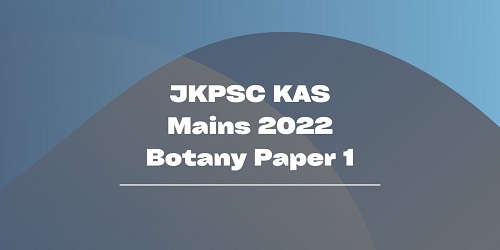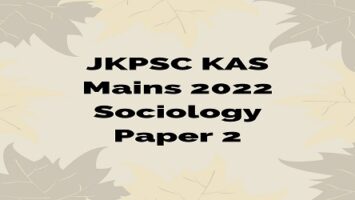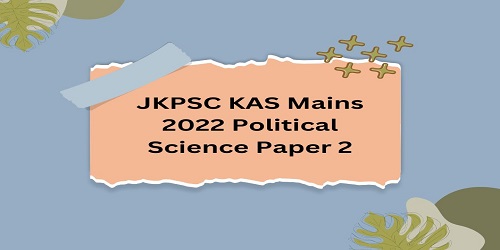JKPSC KAS Mains 2022 Botany Paper 1:
INSTRUCTIONS
Please read each of the following instructions carefully before attempting the paper.
(i) There are eight questions divided in two Sections and printed in English. Candidate has to attempt Five questions in All. Questions No. 1 and 5 are compulsory and out of the remaining, any Three are to be attempted choosing at least One question from each Section. The number of marks carried by a Question/Part is indicated against it. Answers must be written in English in Question-Cum-Answer (QCA) Booklet in the space provided.
(ii) Your answer should be precise and coherent.
(iii) If you encounter any typographical error, please read it as it appears in the text book.
(iv) Candidates are in their own interest advised to go through the general instructions on the back side of the title page of the Answer Script for strict adherence.
v) No continuation sheets shall be provided to any candidate under any circumstances.
(vi) No blank page be left in between answer to various questions.
SECTION- A
1. Write short notes on:
(a) Why bryophtes are called amphibians of plant kingdom? (10)
(b) Economic importance of algae. (10)
(c) Applications of plant tissue culture. (10)
(d) Chemotaxonomy. (10)
(e) Endosperm- development and functions. (10)
2. (a) Outline the beneficial roles of microbes in agriculture, health care and industry. (20)
(b) Comment on stelar evolution in vascular cryptogams. (20)
(c) Write the botanical name, family, morphology of the economically important part, and uses, of ONE representative each from cereals, spices, beverages, timber, and drug-yielding plants.
3. (a) How are fossils studied? List the various kinds of fossils with examples. (20)
(b) Compare and contrast pteridophytes and gymnosperms. (15)
(c) List the distinguishing features of Brassicaceae, Euphorbiaceae, and Liliaceae. Draw the floral diagram and give floral formula of any representative member.
4. (a) Describe the symptoms, causal organisms and remedial measures of plant diseases caused by ONE viral and One fungal pathogen. (20)
(b) Comment on different kinds of stomata with the help o suitable drawings. (15)
(c) Distinguish between any THREE: (15)
(i) Ring porous and diffuse porous wood
(ii) Leaf anatomy of C3 and C4 plants
(iii) Glandular and non glandular hairs
(iv) Monocot and dicot root
(v) Chlorophyceae and Rhodophyceae
SECTION- B
5. Write briefly about:
(a) Energy plantations. (10)
(b) Microsporogenesis in angiosperms. (10)
(c) Centres of origin of cultivated plants. (10)
(d) Plant quarantine. (10)
(e) Cycadales. (10)
6. (a) Explain the evolutionary significance of heterospory and seed habit in pteridophytes. (20)
(b) Distinguish between bacteria, viruses and mycoplasma and describe how they multiply. (15)
(c) Briefly describe the techniques and applications of embryo rescue. (15)
7. (a) Describe Palynology and it’s applications. What are the various methods of pollen storage? (20)
(b) Define the terms totipotency, somatic hybridization, and somaclonal variation and mention their applications. (15)
(c) Explain unusual (anomalous) secondary growth with suitable illustrations. (15)
8. (a) Elaborate on how Apomixis and Polyembryony are useful in crop production. (20)
(b) Enumerate the merits and demerits of Bentham and Hooker’s system of classification. (15)
(c) What is the significance of Ethnobotany in India? (15)









Comments (No)